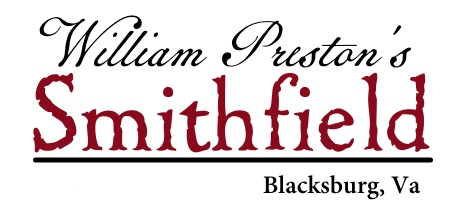Office/School Room
This room had a two-fold purpose: a School Room, for the Preston children and an Office for William Preston, which he used to conduct his business as a county surveyor. Preston was a military and diplomatic leader - these positions clearly showcase his wide variety of leadership skills that established him as a role model and leading citizen in the early community. William Preston was a surveyor by trade and this was how he amassed much of his wealth.
Surveying as a profession showcases American ingenuity. “Preston served as the Deputy surveyor for Augusta County from 1752 - 1770 and became Deputy surveyor of the newly formed Botetourt County in 1770”. (this is where Greenfield was located). (In The True Blue’s Wake, p12) The mapping of new territory demonstrates the European mindset of the new American Dream and showcases the permissibility and entitlement to own land - owning new land was expected and was seen as a right, as an “inheritance” of white settlers, regardless of the current occupation of indigenous tribes. William Preston surveying lands that were not his demonstrates this sense of American optimism of growing and conquering, as well as this sense of entitlement.
Education: Preston was highly committed to the education of all 12 of his children; it was written in his will that on his death, Susanna could continue to live at Smithfield as long as she never remarried and if she made plans to provide a continued and thorough education for all of his children, boys and girls. Preston’s commitment to education shows through the various generations of the Preston family - from this family came multiple state governors, multiple Presidents/early trustees of institutions of higher education (Washington and Lee, Emory and Henry University, Virginia Tech, The Virginia Military Institute, The University of Virginia, specifically) and much more. Though at the time, it was illegal in many states to teach enslaved people to read and write, we know that enslaved people were able to learn these skills regardless.
One such instance is the story of Thomas, Othello and Oscar Fraction: When the Union Army traveled through Montgomery County in 1865, three enslaved brothers (Oscar, Thomas and Othello Fraction) of Greater Smithfield [specifically of Solitude] escaped slavery and joined the 40th United States Colored Infantry. The brothers wrote letters back to their families, saying that they planned to return to visit. Robert Taylor Preston of Solitude intercepted the letters and told the brothers that if they returned, he would shoot them. The brothers demonstrated immense courage in their reply, by saying that “they were soldiers now, and that they’d shoot back.”
When they returned for their family, Robert Taylor Preston threatened the Fraction men with gun violence. After a brief shootout, Thomas Fraction was jailed, his rank of Sergeant was stripped away and he was dishonorably discharged. In a 2021 ceremony at Smithfield, the United States Army posthumously awarded Thomas an honorable discharge and reinstated his rank. George Washington: In the School Room, we showcase a portrait of George Washington. George Washington and William Preston were acquaintances and professional colleagues as both men were soldiers as well as surveyors. We know that William Preston accompanied George Washington for a few days in October of 1756 while Washington made his frontier tour to inspect area fortifications. There is no proven instance that we are aware of that says George Washington spent time at Smithfield, but it is possible, as the two men knew one another well and were together on multiple occasions. We have two artifacts that help establish this connection between Washington and Preston, detailed below.
William Preston's Snuffbox, c. 18th century
This wooden snuff box resides in Case 4 in Smithfield's Museum, which contains first, second and third generation Preston artifacts. This snuffbox is reported to have been given to William Preston by George Washington as a gift of thanks after Preston saved Washington's life during an indigenous ambush. The snuffbox is hand carved wood, with a flush top hinge at the back, a thumb piece on the front, and silver foil lining. On the exterior of the lid is a hand-painted scene of two men and dogs hunting birds. The bottom and four sides show a delicate pattern of painted leaves and linework. Despite its age, this artifact is in excellent condition, which may point to the box's personal significance to William Preston. Snuff boxes are small, usually ornamented boxes used to store snuff, a scented, powdered tobacco.
The Washington Invitation
Also included in our museum is an invitation from President Washington inviting William Preston's son, Francis Preston to dinner at the executive mansion in Philadelphia, PA in January of 1797.
